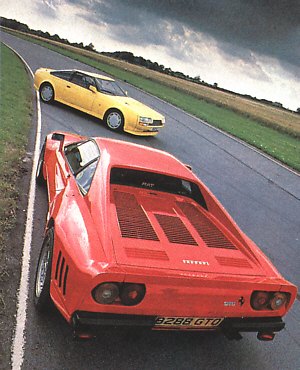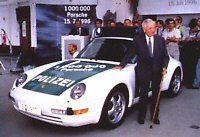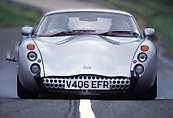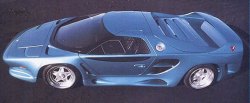


| An interesting scene. Apart from performance, these two supercar legends are hardly comparable. 5.3-litres vs 32-valve plus twin-turbo ? Classic Weber cab vs modern electronic injection ? Leather vs carbon fiber ? Front-engined vs Mid-engined ? Tall vs low ? Angular vs curvy ? Well done Zagato, you made one of the most unique supercars. Well done Ferrari, you established the supercar standard for Aston to diversify. |
Time TunnelThe 1 millionth Porsche On the 15th July 1994, Porsche produced its 1,000,000th cars, a 993 Carrera for the Police. The late Ferry Porsche celerated that moment with his fellows. Among the production, some 419,000 cars were 911, followed by 924/944/968 series at 325,000 units, then the short-lived 914 at 118,000 cars and then the 356 at 77,000 units. |
Moby Dick ! Recently,
I read the fiction "Moby Dick". Surprisingly, the white whale didn’t
appear
until the last 25 pages, by then I’ve already went through 250 pages !
TVR Tuscan emerged in the same way. We was told that 1999 should be the
Tuscan year, but after waiting so long, it was still undergoing the
final
phase of test. I really hope next spring will be the Tuscan’s Page 250. Recently,
I read the fiction "Moby Dick". Surprisingly, the white whale didn’t
appear
until the last 25 pages, by then I’ve already went through 250 pages !
TVR Tuscan emerged in the same way. We was told that 1999 should be the
Tuscan year, but after waiting so long, it was still undergoing the
final
phase of test. I really hope next spring will be the Tuscan’s Page 250.
|
| Reader's Letter | ||||
|
I
noticed on
your webpage that you were wondering if it was possible for the Vector
to have produced 700 hp from a 7 liter pushrod V8. Being a fan of
American muscle cars, I thought perhaps I could shed some light on this
subject. Although it's seldom tried due to the expense compared
with
supercharging or just making the engine bigger, making 100 hp per liter
is not impossible for a pushrod V8. The question is not whether
this
was possible for the Vector, but whether it could be driven on the
street
with anything resembling reliability. One recently published example is in the November 1999 issue of Car Craft. I'm not sure if you get that magazine where you live, but it's a fairly popular magazine about muscle cars in the United States. One article, entitled "Pros & Cons of a 10-Second Street Car," went into the details of a '70 Dodge Coronet Super Bee built to run the standing quarter mile in slightly over 10 seconds. The car weighed in at an immense 3,860 lbs, and the engine put out 751 horsepower from about 7.9 liters, naturally aspirated. That isn't quite 100 horsepower per liter, but the engine could be pushed further. In addition to push rods, it also uses a single carburetor with four barrels. The engine puts out so much power that it often runs the risk of damaging the transmission (which, like the Vector's, is a three speed automatic). Another article in the same magazine describes a naturally aspirated 5.0 Mustang engine, which is also capable of being street driven, and also runs the standing quarter mile in approximately 10 seconds. The power output of the engine is not given, but a Mustang is likely to require at least 500 hp, and probably more, to run the quarter mile that fast. Of course, this does not answer the question as to whether the engine in the Vector actually produced 700 hp, or if it could have lasted for long on the street with such a high power output. It appears that this was possible in theory, but in practice would have required going to extremes that would cause problems on a street car. I hope this answers some of your questions about the Vector's engine! Matt Crame
|
|||
| Suddenly
many readers talk about Vector. More precisely, talk about my Vector
page
in the Strange Car section. For any people other than American,
believing
a push-rod 7-litre V8 outputting 700hp is simply unbelievable. But our
Uncle Sam always says nothing is impossible in America. He argue that
pushrod
engine had been proved as capable of running to 800hp in NASCAR, or
1600hp
in dragsters. He pointed out that there are many modified cars in
America
capable of reaching 100hp/litre while costing just a few hundred
dollars
for modifications. Is America really a dreamland ?
If so, Ford Mustang SVT wouldn’t have been accused for producing just 280hp rather than the claimed 320hp, Callaway C12 wouldn’t have had just 465hp out of 6.3 litres (or in Uncle Sam’s words, 382 cubic inches) and the 8-litre Dodge Viper would have doubled its horsepower. Dream is dream, reality is reality. We, non-American, do not necessarily hate push-rod engines. However, in terms of top end power efficiency, it is just the basic theory (that every mechanical engineers know) tells us that the push-rod type valve gear is not the most optimised design. Not just because the long and heavy push-rods limit the revvability of the engine, but also because we assume all push-rod engines have just 2 valves per cylinder, without variable valve timing. Both limit the efficiency of breathing. If you believe the Vector’s push-rod V8 had 700hp on tap, then the contemporary McLaren F1 would have had 1000hp. No, the 48-valves, variable valve timing BMW V12 just produced 103hp per litre, versus Vector’s 100hp per litre. And who dare to say the Vector made better engine than BMW’s Motorsport department ? |
 If it is AMG or Callaway, I have no problem of believing it’s claimed power. But this is VECTOR, the most notorious supercar maker in the world. All the stunning claimed performance data were not testified by car magazines. The same for car modifiers. Tuners may claim big figures, saying they had reached that on the test bed. But the cars provided for car magazines were always said as "detuned" version because the development was still undergoing. Who knows how they tested the engine on the test bed ? For how long ? By re-programming the engine management system alone, you may get 100 more horsepower, but the engine would neither last the first 1,000 miles nor pass the emission test. That’s why they always lend the "detuned" version for journalists testing. So what’s the point of saying some racing cars have push-rod engines delivering 100hp/litre ? Racing car is racing car. They run on high Octane petrol (e.g., Formula One is 102 RON, versus the best 98 RON you can get in your gas station.) so to enable a compression ratio of probably 14:1. Our best road cars are just around 11.0:1. Direct injection might improve that a little bit. As a result, racing engine squeeze more horsepower out of the same capacity. Racing engines are designed to complete the race distance and no more. As long as it is enough to do so, all the extra weight are going to be cut in order to increase rev and power. For instance, the light weight valves, connecting rod, piston etc. might not be reliable enough for road use. |
Then comes the emission regulations, which further limit the horsepower of our road cars. Adding all these, it is impossible to prove the feasibility of 100hp/litre road-used push-rod engine based on the "evidence" from motor racing. What about the muscle cars in the 60’s and 70’s ? Didn’t they prove that push-rod engine could be highly efficient ? No. Their headline-topping horsepower figures always worth doubting. Firstly, the race for horsepower in the muscle car era might push the Big Three to claim bigger numbers than the real ones. Secondly, in those years power were measured as Net rather than today’s Gross. An example would give you a clearer view - the Jaguar XKE V12 claimed 272hp (Gross) or 317hp (Net), the latter is 16.5% up from the Gross power ! Uncle Sam also told us his experience of riding on a 70’s muscle car. He insisted he felt the POWER of the push-rod engine and recorded a fabulous quarter-mile time. Unluckily, it is the TORQUE and gearing that dictate the acceleration, not the top end power. You cannot testify the power without running to maximum speed. Well, for a 450-horsepower muscle car, the top speed is likely to be 180mph I think …. did Uncle Sam ever reached that ? That’s enough. Those enjoy watching NASCAR and drag racing might think different from the rest of the world. And the rest of the world would never understand how "great" the push-rod engines are, excluding about their size. - Mark Wan |